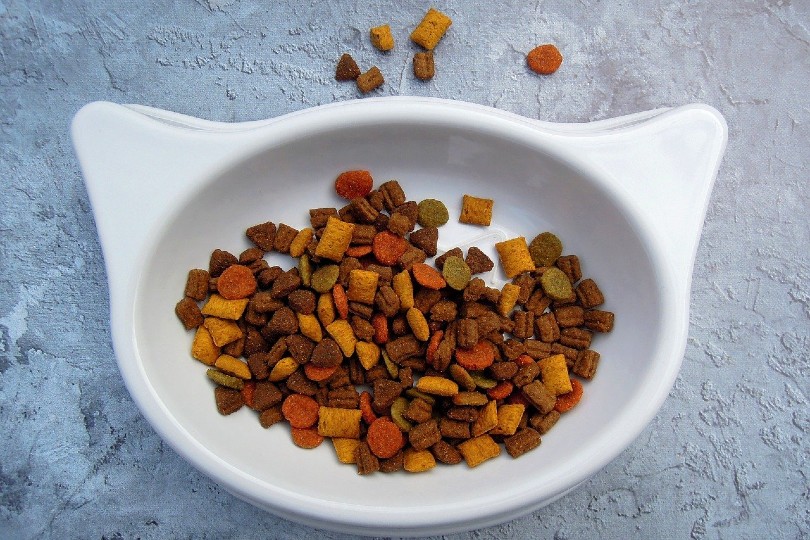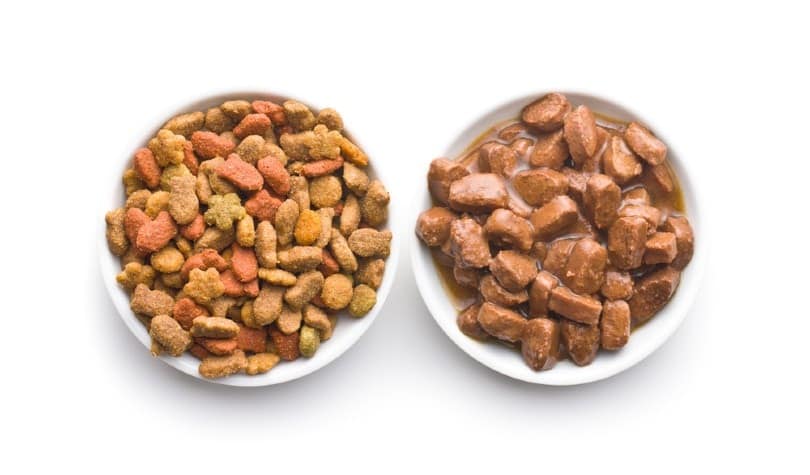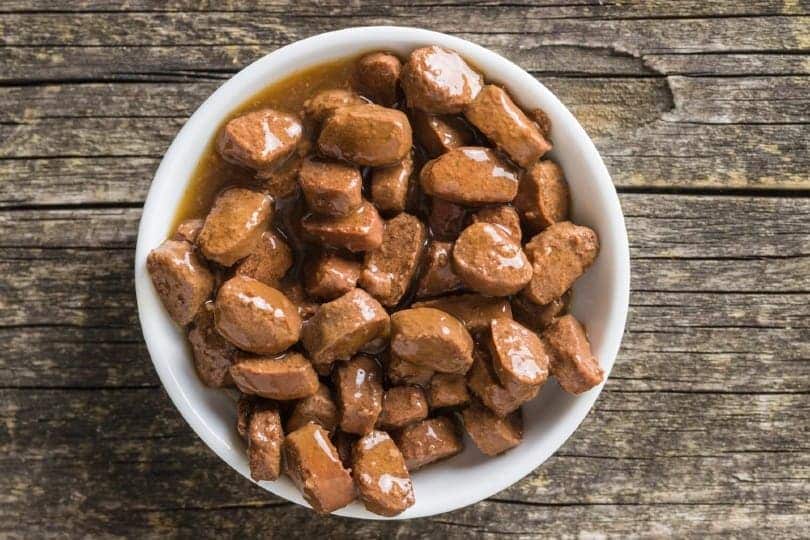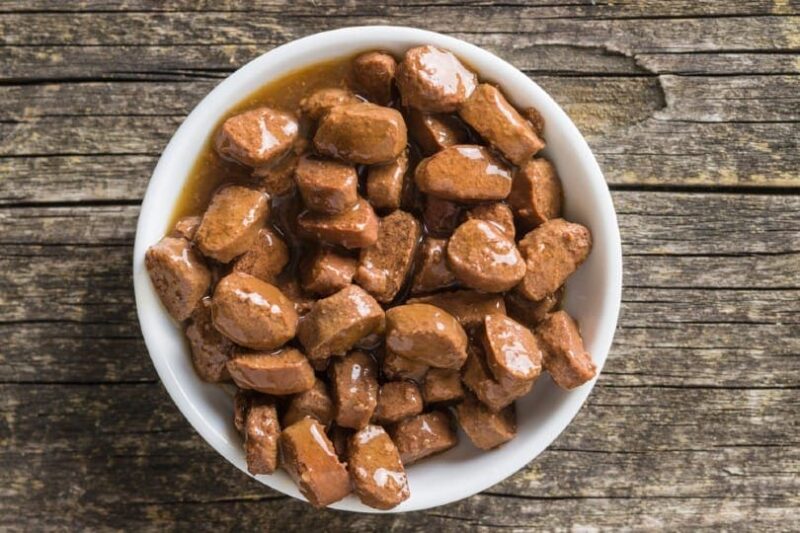Have you ever been putting together your cat’s meal for the night and thought to yourself, “Wow, I want to taste this delicious cat food! It seems so gourmet!” In general, cat food doesn’t smell or look terribly appetizing, but to each their own!
Whether you’re interested in eating cat food for the taste or out of necessity, this article aims to inform you of the safety of such an action. Luckily, there’s nothing in cat food that should kill you or cause an immediate and awful reaction, but that doesn’t mean we recommend substituting it for your dinner.
Delicious Labels
Like any product, cat food companies try to entice you with clever language to entice you into buying their formulas. One way they do this is by using names that appeal to people. After all, your cat isn’t reading the label on its food, you are. So, advertisers try to pick names that you might want to eat yourself. If something sounds tasty, you’ll want to give it to your cat.
- Grilled Chicken and Cheddar Cheese Feast in Gravy
- Ocean Whitefish and Tuna Dinner
- Savory Chicken Entrée
- Tender Beef Feast
If a microwave dinner had the same name as any of these cat foods, you probably wouldn’t hesitate to buy it. So, it’s unsurprising that some people try their cat’s food.

FDA Oversight
In America, all pet foods are subject to oversight by the Food and Drug Administration. Individual states each handle the regulatory work following guidelines set by the Association of American Feed Control Officials, and there are several regulations and strict standards that pet food manufacturers must meet.
However, these standards are not the same ones imposed on food made for humans. Because of that, if you get sick eating pet food, you may not have many options for legal recourse.
It is worth noting that some cat food brands, products, and recipes are human-grade products and meet requirements deemed safe for human consumption.
Nonetheless, they aren’t exactly meant for us to eat, but rather a form of advertisement for the food instead. Pet food companies like to show their products are human-grade because it reassures owners that their pets are fed food that’s just as good for humans. Many pet owners find this comforting, as offering their pets the best possible nutrition is one of the best ways they can care for them.
However, the formulation might still be inappropriate for human consumption. Generally speaking, human-grade cat food is safe, but it likely has too much protein for the dietary requirements of most humans. It is also not a valid option for vegans or vegetarians.
Food from the Same Farms
Most of the ingredients in your cat’s food come from the same farms that produce the food we eat. There’s a big difference between the ingredients in human food and cat food, however. In human food, only the highest quality parts of each animal are used.
By-products are generally not made into food for humans. You won’t find ground-up bones, scraps, and offal in your TV dinner, but you will in your cat’s food. For cat food, manufacturers use the parts of the animals that weren’t used for human food. While we get good cuts like tenderloins and back straps, everything else goes into cat food, including many parts you’d probably rather not eat.
Canned Cat Food vs Dry

Dry pet food is more susceptible to contamination than food in cans. It’s ripe for E. coli infection and other harmful pathogens. However, canned cat food is sterile because of the canning process. You’re generally better off trying canned cat food than dry kibble.
However, even canned cat food can become contaminated. In 2007, pet food from more than 150 brands was recalled because a Chinese manufacturer added plastic to their protein exports. This resulted in the deaths of multiple pets in the US, and if you had eaten any of that pet food, it could have killed you, too.
Ironically, you’re even more likely to bite into contaminated human food, which is constantly recalled. Shortly after the 2007 recall, baby formula in China was recalled for the same melamine plastic contamination, resulting in over 300,000 sick children and more than a dozen deaths.
What Will Happen if You Eat Cat Food?
So, the big question is: if you eat cat food, what will happen? Truthfully, you’ll probably just be full. Nothing in cat food is indigestible for humans. It’s made from the same foods we regularly eat. The difference is in the quality. High-quality ingredients are used for human food, but the lower-quality equivalents end up in pet food. Eating a single meal of cat food poses no real health risks.
However, there are health risks that could be associated with long-term consumption of cat food. Even though it’s made of ingredients we commonly eat, it lacks some vital nutrients that cats don’t need, but we do.
For example, vitamin C can be produced by your cat’s body, so it’s not included in cat food. You can’t produce this vitamin, and without it, you could suffer severe consequences, including scurvy, which occurs as a result of a vitamin C deficiency.
Conclusion
All in all, eating cat food is not unsafe but is unhealthy. Canned food is safer than dry kibble since canned food is generally considered sterile. We probably wouldn’t eat either, but if you choose one, human-grade canned food is the way to go if you’re keen on satiating your curiosity about cat food. However, don’t eat cat food frequently.
While it doesn’t pose any severe health risks when consumed in small amounts, long-term consumption can lead to deficiencies and health issues you’d be better off avoiding. We’ll stick to the other parts of the grocery store for our meals and only purchase food for our cats from the pet section!
Featured Image Credit: Jiri Hera, Shutterstock













